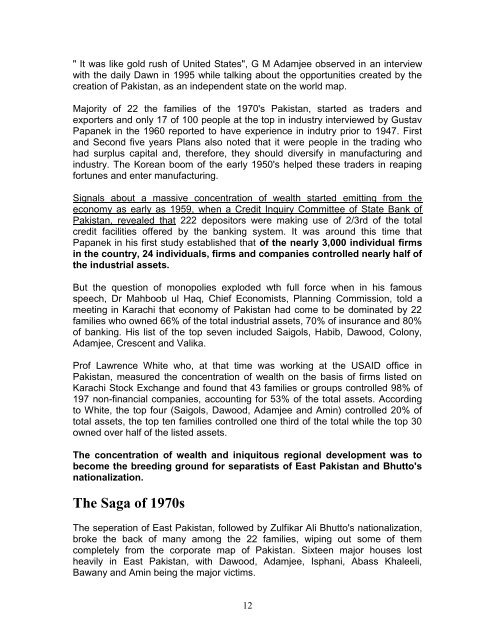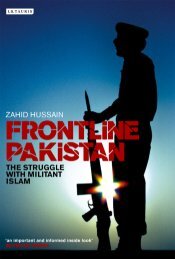Who Owns Pakistan - Yimg
Who Owns Pakistan - Yimg
Who Owns Pakistan - Yimg
Create successful ePaper yourself
Turn your PDF publications into a flip-book with our unique Google optimized e-Paper software.
" It was like gold rush of United States", G M Adamjee observed in an interview<br />
with the daily Dawn in 1995 while talking about the opportunities created by the<br />
creation of <strong>Pakistan</strong>, as an independent state on the world map.<br />
Majority of 22 the families of the 1970's <strong>Pakistan</strong>, started as traders and<br />
exporters and only 17 of 100 people at the top in industry interviewed by Gustav<br />
Papanek in the 1960 reported to have experience in indutry prior to 1947. First<br />
and Second five years Plans also noted that it were people in the trading who<br />
had surplus capital and, therefore, they should diversify in manufacturing and<br />
industry. The Korean boom of the early 1950's helped these traders in reaping<br />
fortunes and enter manufacturing.<br />
Signals about a massive concentration of wealth started emitting from the<br />
economy as early as 1959, when a Credit Inquiry Committee of State Bank of<br />
<strong>Pakistan</strong>, revealed that 222 depositors were making use of 2/3rd of the total<br />
credit facilities offered by the banking system. It was around this time that<br />
Papanek in his first study established that of the nearly 3,000 individual firms<br />
in the country, 24 individuals, firms and companies controlled nearly half of<br />
the industrial assets.<br />
But the question of monopolies exploded wth full force when in his famous<br />
speech, Dr Mahboob ul Haq, Chief Economists, Planning Commission, told a<br />
meeting in Karachi that economy of <strong>Pakistan</strong> had come to be dominated by 22<br />
families who owned 66% of the total industrial assets, 70% of insurance and 80%<br />
of banking. His list of the top seven included Saigols, Habib, Dawood, Colony,<br />
Adamjee, Crescent and Valika.<br />
Prof Lawrence White who, at that time was working at the USAID office in<br />
<strong>Pakistan</strong>, measured the concentration of wealth on the basis of firms listed on<br />
Karachi Stock Exchange and found that 43 families or groups controlled 98% of<br />
197 non-financial companies, accounting for 53% of the total assets. According<br />
to White, the top four (Saigols, Dawood, Adamjee and Amin) controlled 20% of<br />
total assets, the top ten families controlled one third of the total while the top 30<br />
owned over half of the listed assets.<br />
The concentration of wealth and iniquitous regional development was to<br />
become the breeding ground for separatists of East <strong>Pakistan</strong> and Bhutto's<br />
nationalization.<br />
The Saga of 1970s<br />
The seperation of East <strong>Pakistan</strong>, followed by Zulfikar Ali Bhutto's nationalization,<br />
broke the back of many among the 22 families, wiping out some of them<br />
completely from the corporate map of <strong>Pakistan</strong>. Sixteen major houses lost<br />
heavily in East <strong>Pakistan</strong>, with Dawood, Adamjee, Isphani, Abass Khaleeli,<br />
Bawany and Amin being the major victims.<br />
12













